
Key on-chain metrics suggest a higher baseline for Bitcoin price now that the halving is complete.
Cryptocurrency Financial News

Key on-chain metrics suggest a higher baseline for Bitcoin price now that the halving is complete.
David Lawant, Head of Research at FalconX, a digital assets prime brokerage with trading, financing, and custody for leading financial institutions, recently offered an analysis on X (formerly Twitter) regarding the evolving role of Bitcoin halvings in market dynamics. This analysis challenges the traditional view that halvings directly and significantly affect Bitcoin’s price, instead highlighting a broader economic and strategic context that might be influencing investor perceptions and market behavior more profoundly.
Lawant begins by addressing the changing impact of Bitcoin miners on market prices. He presents a detailed chart comparing the total mining revenue to the Bitcoin spot traded volume from 2012 onwards, clearly marking the dates of the three previous halvings. This data reveals a significant shift: “The most crucial chart for comprehending halving dynamics is the one below, not the price chart. It illustrates the proportion of total mining revenue compared to BTC spot traded volume since 2012, with the three halving dates marked.”
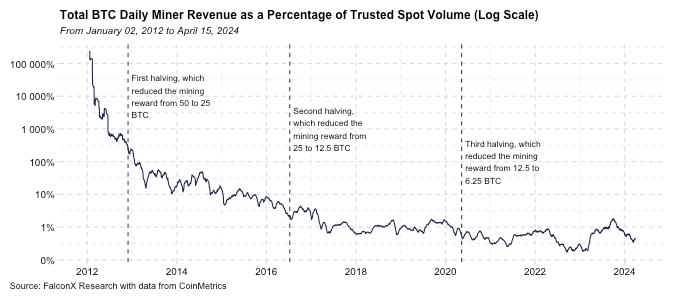
In 2012, total mining revenue was multiples of the daily traded volume, highlighting a time when miners’ decisions to sell could have significant impacts on the market. By 2016, this figure was still a notable double-digit percentage of daily volume but has since declined. Lawant emphasizes, “While miners remain integral to the Bitcoin ecosystem, their influence on price formation has notably waned.”
He elaborates that this reduction is partly due to the increasing diversification of Bitcoin holders and the growing sophistication of financial instruments within the cryptocurrency market. Furthermore, not all mining revenue is immediately impacted by halving events—miners may choose to hold onto their rewards rather than sell, affecting the direct impact of reduced block rewards on supply.
Lawant connects the timing of halvings to broader economic cycles, proposing that halvings do not occur in isolation but alongside significant monetary policy shifts. This juxtaposition increases the narrative impact of halvings, as they underscore Bitcoin’s attributes of scarcity and decentralization during periods when traditional monetary systems are under stress.
“Bitcoin halving events tend to occur during critical monetary policy turning points, so the narrative fit is just too perfect to assume they cannot influence prices,” Lawant observes. This statement suggests a psychological and strategic dimension where the perceived value of Bitcoin’s scarcity becomes more pronounced.
The analysis then shifts towards the macroeconomic environment influencing Bitcoin’s appeal. Lawant references the 2020 discussion by investor Paul Tudor Jones who labeled the economic climate as “The Great Monetary Inflation,” a period marked by aggressive monetary expansion by central banks. Lawant argues, “I’d argue that this was a more important factor in the 2020-2021 bull run than the direct flow impact from the halving,” pointing out that macroeconomic factors may have had a more substantial influence on Bitcoin’s price than the halving itself.
Future Prospects: Macroeconomics Over Mechanics
Looking towards the future, Lawant speculates that as the world enters a new phase of economic uncertainty and potential monetary reform, macroeconomic factors will increasingly dictate Bitcoin’s price movements rather than the mechanical aspects of halvings.
“Now in 2024, the concerns center around the aftermath of the fiscal/monetary policies that have been in place for decades but are getting turbocharged in a world that is very different from four years ago. […] We are potentially entering a new leg of this macroeconomic cycle, and macro is becoming a more critical factor in BTC price action,” he concludes.
This perspective suggests that while the direct price impact of Bitcoin halvings may diminish, the broader economic context will likely highlight Bitcoin’s fundamental properties—immutability and a fixed supply cap—as crucial anchors for its value proposition in a rapidly evolving economic landscape.
At press time, BTC traded at $62,873.
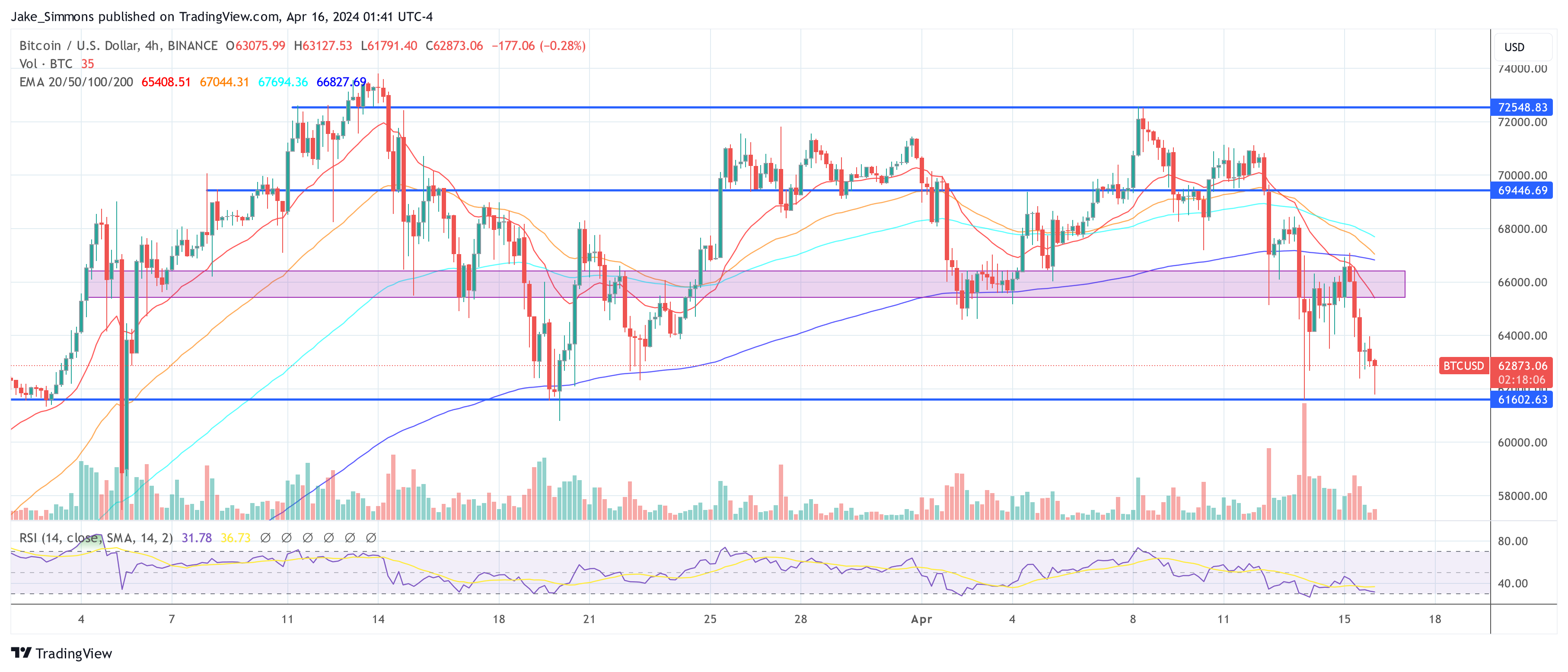
The Bitcoin Halving is fast approaching, with less than 2,900 blocks left before miners’ rewards are cut in half. This event, projected to take place sometime in April, is significant as Bitcoin’s price could enjoy a parabolic move to the upside after it takes place.
Data from Coinwarz shows that the Bitcoin Halving is set to take place on April 19 at Block 840,000. This projection is based on Bitcoin’s current block time average, which means the Halving can come a little earlier or sometime after April 19. However, the main focus remains that miners’ supply will be cut in half.
The Halving event is a deflationary measure that Bitcoin’s founder, Satoshi Nakamoto, encoded in the flagship crypto and takes place after every 210,000 blocks. Three halving events have occurred since the Genesis block in 2009, when Bitcoin’s first block was mined. The first was on November 28, 2012, when miners’ rewards were cut from 50 BTC to 25 BTC.
The next Halving event took place on July 9, 2016, cutting miners’ rewards to 12.5 BTC. The third one happened on May 11, 2020, reducing the reward to 6.25 BTC. Now, Miners’ rewards are set to be cut in half again, reducing them to 3.125 BTC.
This reward is the amount of BTC miners receive for validating each block of new transactions on the blockchain. Although this event mainly affects miners, the crypto community closely monitors it due to the ripple effects it could have on the market. Bitcoin’s supply comes through these miners’ rewards, and a reduction in them usually drives Bitcoin’s value higher.
The Halving has historically always led to a price appreciation for Bitcoin. Ninety days after the first Halving on November 28, 2012, Bitcoin’s price increased to $1,000 from $12 at the time of Halving. Subsequently, Bitcoin’s price saw a gain of over 8,000% one year after that Halving.
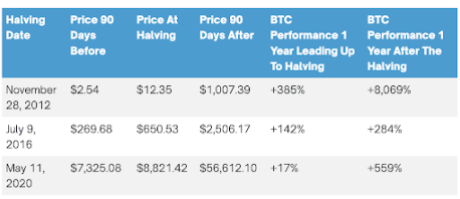
This parabolic price surge also occurred after the second and third Halving events, with Bitcoin’s price rising from $650 and $8,821 (at the time of the Halving) to $2,506 and $56,612 (90 days after the Halving) in 2016 and 2020 respectively. Bitcoin also gained 284% and 559% one year after the event.
This time isn’t expected to be different as Bitcoin is again predicted to experience a massive move to the upside after April. This bullish sentiment is further strengthened by Bitcoin’s demand, which has continued to skyrocket in the face of a dwindling supply.
At the time of writing, Bitcoin is trading at around $70,400, up in the last 24 hours according to data from CoinMarketCap.
Mike Alfred, a Bitcoin investor and crypto commentator, thinks the “big money algos” are back and predicts the world’s most valuable cryptocurrency will rally to record fresh February 2024 highs but retest all-time highs. This uptick, Alfred says, is before the network finally halves its miner rewards.
Taking to X on February 20, the investor notes that “big money algos just flipped on” and that the uptrend remains. By the time Alfred posted on X, BTC was headed towards the $53,000 before slipping back slightly to around the $59,000 level.
However, the uptrend remains when looking at the candlestick arrangement in the daily chart. Bitcoin has been increasing, defying gravity for the better part of February. At spot rates, analysts, including Alfred, expect the coin to push higher, breaking above $53,000, a stubborn resistance level. If this happens, and considering the sharp breakout, it is likely that buyers will push prices higher towards $60,000 and potentially towards $70,000, as the investor predicts.
Even so, it remains to be seen whether the uptrend will be sustained. When writing, the breakout has been met with solid rejection. Notably, there appear to be “sell walls,” which are large sell orders parked at around $53,000. Still, optimistic bulls expect a triumph, marked by a comprehensive close above this psychological round number.
The crypto community, including the investors, is bullish on Bitcoin. So far, anticipation has been building up for even more gains ahead of halving. Bitcoin halving, an event set at the protocol level, will half miner rewards, possibly inducing a supply shock, assuming the current demand increases.
Presently, Bitcoin supporters believe the network will continue to find more adoption as a medium of exchange and a store of value. With the coin becoming deflationary after halving, the consensus is that prices, guided by historical performance, will rise.
While optimism reigns, Bitcoin remains volatile despite recent institutional participation. Through the spot Bitcoin exchange-traded funds (ETFs), Wall Street players have found a regulated product to channel billions into Bitcoin, reading from the amount of coins scooped in the recent past.
Still, whether the uptrend will continue depends on other macro factors, including monetary policy status in the United States. In March, the United States Federal Reserve (Fed) will guide the interest rate regime. It is a decision that may lift BTC to new levels as a store-of-value asset or force prices lower as capital rotates that to the greenback.
Feature image from Shutterstock, chart from TradingView
In Grayscale’s latest report, “2024 Halving: This Time It’s Actually Different,” Michael Zhao, provides an in-depth analysis of the evolving dynamics within the Bitcoin ecosystem as the next halving event approaches in mid-April 2024. The report argues for a significant departure from previous cycles, underlined by the advent of spot Bitcoin ETFs in the United States, evolving investment flows, and innovative use cases emerging within the Bitcoin network.
Halvings, designed to halve the reward for mining Bitcoin transactions every four years, are pivotal in maintaining Bitcoin’s scarcity and disinflationary profile. Zhao articulates, “This disinflationary characteristic stands as a fundamental appeal for many Bitcoin holders,” emphasizing the stark contrast with the unpredictable supplies of fiat currencies and precious metals.
Despite historical price surges post-halving, Zhao cautions against assuming such outcomes as guarantees, stating, “Given the highly anticipated nature of these events, if a price surge were a certainty, rational investors would likely buy in advance, driving up the price before the halving occurs.”
Macroeconomic Factors
According to Zhao, macroeconomic factors have differed in each cycle, however, always propelling the BTC price to new heights. The researcher describes the European debt crisis in 2012 as a significant catalyst for Bitcoin’s rise from $12 to $1,100, highlighting its potential as an alternative store of value amidst economic turmoil,
“Similarly, the Initial Coin Offering boom in 2016—which funneled over $5.6 billion into altcoins—indirectly benefited Bitcoin as well, pushing its price from $650 to $20k by December 2017. Most notably, during the 2020 COVID-19 pandemic, expansive stimulus measures […] [drove] investors towards Bitcoin as a hedge, which saw its price escalate from $8,600 to $68k by November 2021,” Zhao states.
Thus, Zhao suggests that while the halvings contribute to Bitcoin’s scarcity narrative, the broader economic context is also always critically impacting Bitcoin’s price.
Miners’ Strategic Adjustments
Anticipating the next BTC halving in April, miners have proactively adjusted their strategies to counterbalance the impending reduction in block reward income amidst escalating mining difficulties. Zhao observes a strategic move among miners, noting, “There was a noticeable trend of miners selling their Bitcoin holdings onchain in Q4 2023, presumably building liquidity ahead of the reduction in block rewards.
This foresight suggests miners are not merely reacting but are actively preparing to navigate the challenges ahead, ensuring the network’s resilience. “These measures collectively suggest that Bitcoin miners are well-positioned to navigate the upcoming challenges, at least in the short term,” the Grayscale researcher argues.
The Emergence Of Ordinals And Layer 2 Solutions
The introduction of Ordinal Inscriptions and the exploration of Layer 2 solutions have introduced new dimensions to Bitcoin’s functionality and scalability. Zhao emphasizes the significance of these innovations, stating, “Digital collectibles…have been inscribed, generating more than $200 million in transaction fees for miners.” This development has not only augmented Bitcoin’s utility but also provided miners with new avenues for revenue generation.
Furthermore, Zhao highlights the potential of Layer 2 solutions to address Bitcoin’s scalability challenges, pointing out, “The growing interest in Taproot-enabled wallets…indicates a collective move toward addressing these challenges.” This reflects a concerted effort within the Bitcoin community to enhance the network’s capabilities and accommodate a broader range of applications.
The Role Of ETF Flows
The approval and subsequent introduction of spot Bitcoin ETFs have significantly influenced Bitcoin’s market structure, facilitating wider access for investors and potentially mitigating sell pressure from mining rewards. Zhao articulates the impact of ETF flows, asserting, “Following US spot Bitcoin ETF approvals, the initial net flows…amounted to approximately $1.5 billion in just the first 15 trading days.”
This suggests that ETFs could play a crucial role in balancing the market dynamics post-halving by absorbing a significant portion of the typical sell pressure post-Halving. “In order to maintain current prices, a corresponding buy pressure of $14 billion annually is needed. Post-halving, these requirements will decrease by half: […] that equates to a decrease to $7 billion annually, effectively easing the sell pressure.”
A Promising Outlook for Bitcoin
According to Grayscale’s analysis, the next Bitcoin halving will be different for a number of reasons. Overall, the outlook is highly bullish:
Bitcoin has not only weathered the storm of the bear market but has also emerged stronger, challenging outdated perceptions with its evolution in the past year. While it has long been heralded as digital gold, recent developments suggest that Bitcoin is evolving into something even more significant.
At press time, BTC traded at $49,708.
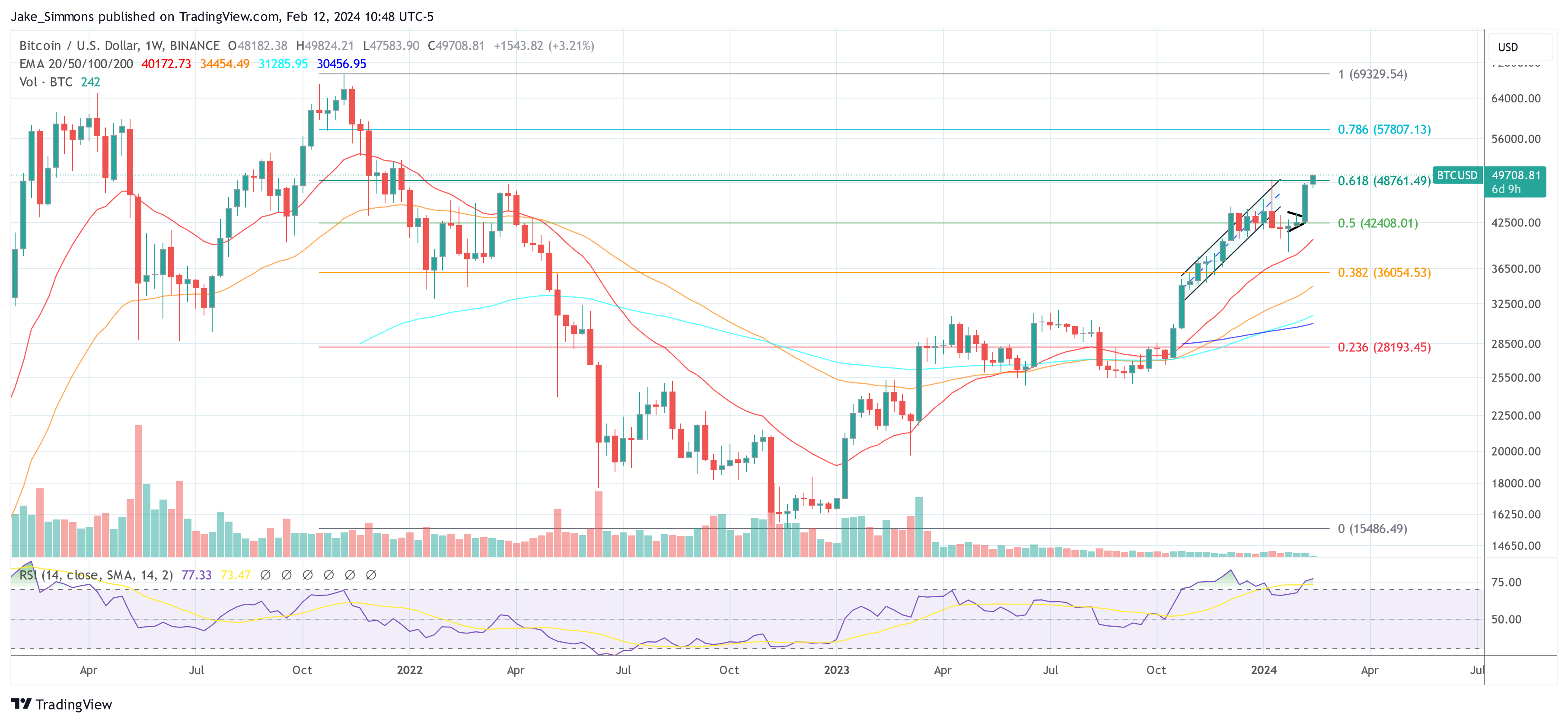
It’s been quite a bearish week for Bitcoin, as the crypto has fallen around 3% since the beginning of the week. Price action, in particular, has had Bitcoin struggling to break above $27,000, indicating a potential risk of more losses below this resistance level in the near term.
However, according to a crypto analyst, this current retracement might be the beginning of a historical Bitcoin cycle before each halving.
Crypto analyst Rekt Capital has said in a post that if historical Bitcoin “halving cycles” are any indication, a major price correction could be right around the corner. The Bitcoin halving cuts the block reward for miners in half.
This happens roughly every 4 years to slow the creation of new BTC and control inflation. Based on historical data from the previous two Bitcoin halvings, the price of BTC could drop by up to 38% before the next halving.
In a chart shared on X (formerly Twitter), Rekt Capital showed a major pull back has happened around six months before each halving. In the 2015 cycle, BTC retraced 25% 196 days before the 2016 halving.
In 2019, BTC retraced 38%, 196 days before the 2020 halving. So with the next halving slated to occur around April 2024, it would seem the market is now in a prime position for the next correction.
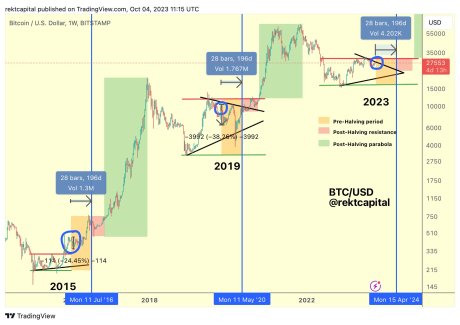
Bitcoin is currently 60% below its all-time high, following a similar pattern with past halvings. 200 days before the 2020 halving, BTC was 60% below its all-time high. Likewise, 200 days before the 2016 halving, BTC was 65% below its all-time high.
Bitcoin’s price direction is currently uncertain, especially as on-chain transactions on the blockchain are now at a three-month low. On-chain metrics have shown that 95% of Bitcoin’s circulating supply hasn’t changed hands in the past month, as investors seem to be holding on to the cryptocurrency in anticipation of the SEC’s approval of spot Bitcoin ETFs.
Although past performance doesn’t always repeat, if this pattern shows up again before the next halving, Bitcoin could be in for a big correction. With the current price of BTC now at $26,770, a 38% retracement could see BTC fall below $18,000. If this happens, it would be devastating for BTC holders.
Even though a price correction may be on the horizon, Bitcoin’s long-term growth prospects remain strong. Over the past decade, Bitcoin has shown a consistent upward trend as the largest crypto by market cap despite facing several setbacks.
Bitcoin has been named the best performer this year in terms of asset investing by Reflexivity, a digital asset research firm. According to billionaire hedge fund manager Paul Tudor Jones, this is the best time to buy BTC.